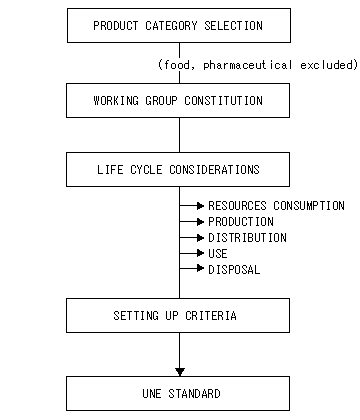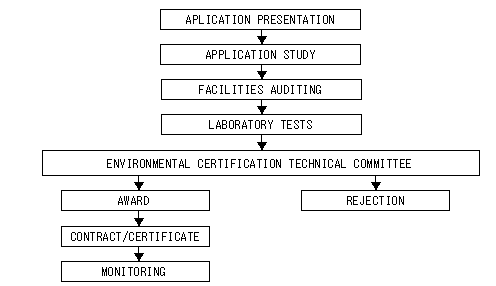


 |
|
 |
 |
 |
Mission: AENOR, Spanish body of private, independent nature, non-profit making, recognized in the national, community and international fields, contributes, by means of the development of STANDARDIZATION and CERTIFICATION activities, towards both the improvement of companies' quality, products and services, and the protection of the Environment, and so, the social welfare. Objectives: The objetives of AENOR-Medio Ambiente are:
Work Program: This award procedure set up the main steps to apply for the use label awarding. 1. Application form Each applicant must present an application form complying with the Regulation for particular products group, which is provide by the AENOR environmental Division. 2. Audit AENOR carries out a previous visit to the applicant facilities, to verify the requirements compliance with the ecological criteria. Besides, a product sample is taken. 3. Testing Required tests by the ecological criteria will be carried out by AN accredited laboratory. 4. Assestment Once the application form is completed and the audit report and test results have been studied, the secretariat of the Environmental Certification Technical Committee proposes the awarding to the Committee. The Environmental Certification Technical Committe is the body that undertake the environmental product issues development and the label AENOR-Medio Ambiente award. This Committee is made up by performers of Manufacturers Associations, Consumers Association, ecological groups, test laboratories and Control and Inspection bodies. 5. Control and Monitoring Once the label is awarded, the product must undergo a periodic control and monitoring, which will take place in the facilities and in the market in order to verify the continuous compliance with the requirements expresed in the ecological criteria.
Procedure for Setting Criteria: 1. PRODUCT GROUP DEFINITION Selection of products which are representative of the market and of the ecological issues, taking account of:
This first step is very important because it could decide the success of the process. The product group is selected depending on the interest showed by the industrial sectors regarding the developing of ecological criteria. 2. FEASIBILITY STUDY After decide in which priorities areas begin to work, AENOR carry out a feasibility study in order to determinate the benefits of undertake this job. In this study there is a phase of information collection in which data are collected on:
3.LIFE CYCLE ASSESMENT CONSIDERATIONS Once it has been decided to open a new project, we look for life cycle studies already available or to contract a consultacy to carry out one if it could be necessary. The conclusions of this study point out the main environmental impacts that have to be intended to reduce through the settlement of the ecological criteria. The parameters identify by the life cycle study are those on which must be made a special point of in order to set the limits expressed in the ecological criteria. 4.CONSTITUTION OF THE WORKING GROUP A new working group is newly formed for each new product group. The task of this group is to discuss proposals regarding criteria and to elaborate a unanimous decision. The working group has an equal representation of all the partners concerned. The composition is as follows:
5.SETTING OF ECOLOGICAL CRITERIA The development of the ecological criteria is based on life cycle assessment. Taking in consideration the Life cycle assessment and through periodical meetings in which all the interested parties have to get an agreement about the parameters to be limit. Once the group have get this consensus this project is sent to the secretary of the Technical standarization committee to be confirm and approved. This process includes a 45 day public review period, in which everybody can send comments to this documents. After review of the public's comments, the criteria must be revised and set the final criteria. 6.UNE STANDARD PUBLICATION This document comprises different parts:
7.DEVELOPE A CERTIFICATION PROCEDURE Add to this, must be developed the certification procedure to be follow in order to verify the compliance with the requirements sets in the ecological criteria. Once there is a technical standard for a product or service group, applicants should send their candidature for the awarding of the mark. On receipt of this application, an auditor is appointed by AENOR to visit the production site and, if necessary, take samples of products to carry out analysis on the products presented. The applicant is awarded when the audit report and test reports establish compliance with technical standard criteria. Once the mark has been obtained, periodic checks are carried out to obtain enough warranty that product follow up provisions implemented by the holder. STAGES FOR SETTING CRITERIA  Certification Procedure: Once ecological criteria have been elaborated and published as Standard, UNE is developing the awarding procedure of the label. 1.APPLICATION PRESENTATION Manufacturers interested in obtaining the label send an application form plus a descriptive information of the product (catalogues, brochures, etc.). This documentation is studied, valuated and accordingly is required further information if necessary. 2.IN SITE AUDIT Auditors of AENOR visit factory sites to check ecological criteria fulfillment. In the process, some samples of products are collected and sent to accredited laboratories. From this first visit we make a report. 3.LABORATORY TESTS. Independent laboratories test the product on the line of the ecological criteria Standard. These laboratories must be accredited by the Entidad Nacional de Acreditacion (ENAC) or Ministry of Industry. 4.EVALUATION The application form is evaluated according to the documentation sent, audit report and test results. The final evaluation report is sent to the Environmental Certification Technical Committee. 5.ENVIRONMENTAL CERTIFICATION TECHNICAL COMMITTEE This Technical Committee is joined by all interested parties: Environmental Ministry, Ministry of Industry, consumers, manufacturers, ecological parties and AENOR, which study the application form and decide if the label must be awarded. If the decision is positive the manufacturer signs a contract for a three years period. 6.COMPLIANCE MONITORING Products with the label are held to a yearly following up to verify the ecological criteria fulfillment, visiting the factory and making laboratory tests as defined in the ecological criteria Standard. The following up result is sent to the Technical Certification Committee. CERTIFICATION PROCEDURE  The Spanish ecolabelling system was created in 1994 with the objectives of promoting the production and use of products and services which reduce the stress on the environment and to provide accurate, verifiable and relevant information to the consumer of environmental aspects of products. Today there are 12 criteria standards approved. Last two criteria standards are related to services. Thus the Marca AENOR-Medio Ambiente has open its scope to products and services. The total number of labelled products or services is over 425. Latest information: So far, the AENOR-Medio Ambiente program has completed 10 sets of criteria. The standard code number and names of these product and services categories are given in table below.
- Criteria under development:
AENOR on INTERNET: http://www.aenor.es |